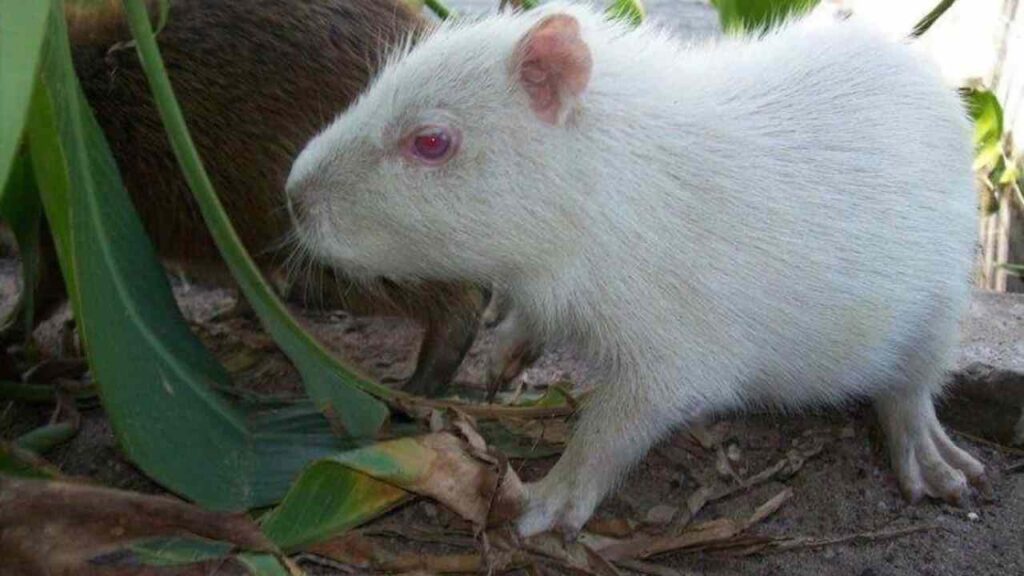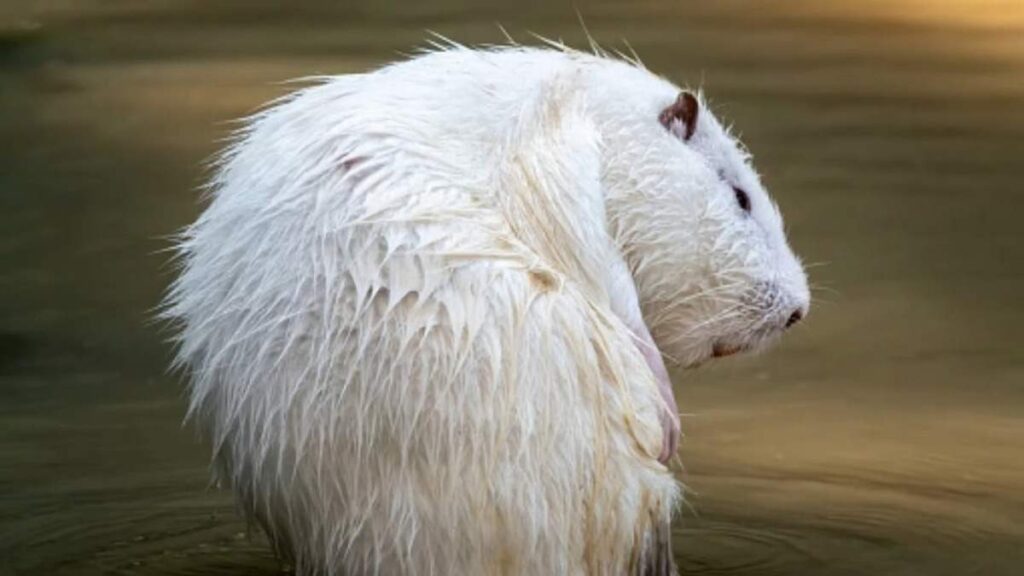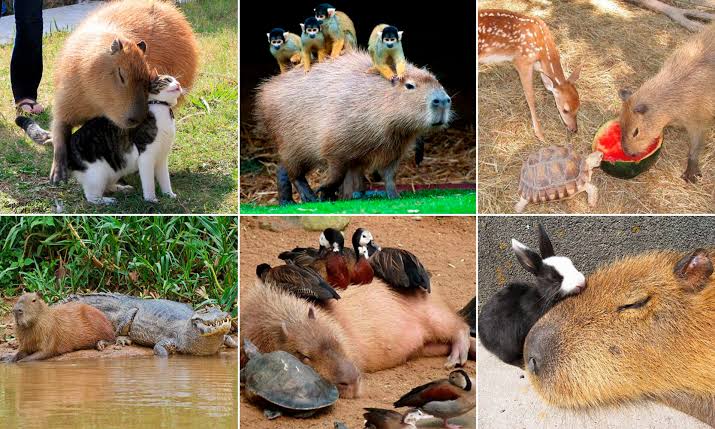Nature never ceases to amaze us with its extraordinary creations, and among its many wonders are the enchanting albino capybaras. These remarkable creatures’ pure white fur and striking pink eyes captivate the imagination and stir curiosity among animal enthusiasts and nature lovers alike.
Through this blog post, we hope to comprehensively understand these mesmerizing creatures and foster a sense of appreciation and responsibility for their well-being.
What Do Albino Capybaras Look Like?

Albino capybaras possess a mesmerizing and distinctive appearance that sets them apart from their regular capybara counterparts. Their physical features, shaped by their lack of pigmentation, create a striking and ethereal allure.
Let’s delve into the fascinating characteristics that define the appearance of albino capybaras and explore the notable distinctions that differentiate them from their non-albino counterparts.
First and foremost, the most striking aspect of albino capybaras is their snow-white fur. Unlike the typical brownish hue of regular capybaras, albino capybaras lack the pigmentation responsible for producing melanin, resulting in their strikingly pale coat. This pure white fur envelops their body, giving them an otherworldly presence.

Complementing their white fur are their captivating pink eyes. The absence of melanin in their iris makes the underlying blood vessels more visible, giving their eyes a unique and mesmerizing pink hue. This feature often captivates the attention of onlookers, creating an enchanting and almost mystical aura.
In addition to their white fur and pink eyes, albino capybaras may exhibit other notable distinctions that further emphasize their uniqueness. Their skin, devoid of pigmentation, appears pale and delicate, lending an air of fragility to their overall appearance. This lack of pigmentation also renders them more susceptible to the harmful effects of sunlight, necessitating additional protection from UV radiation.
While the overall size and body structure of albino capybaras remains similar to that of regular capybaras, their striking lack of coloration truly sets them apart. Their unique features enhance their ethereal beauty, making them stand out as captivating beings in the animal kingdom.

Albino Capybaras Habitat: Exploring Their Preferred Environments
With their striking white fur and pink eyes, these captivating creatures find solace and sustenance in specific environments that cater to their needs.
- Native Range and Geographic Distribution: Albino capybaras, a unique variation of the capybara species (Hydrochoerus hydrochaeris), are primarily found in South America. Their native range spans various countries, including Brazil, Venezuela, Colombia, Argentina, Paraguay, and Uruguay. Within these countries, they inhabit various habitats, displaying remarkable adaptability.
- Wetlands and Riparian Zones: One of the primary habitats favored by albino capybaras is wetlands and riparian zones. These areas, characterized by abundant water sources such as rivers, lakes, and marshes, provide the perfect environment for these semi-aquatic creatures. Albino capybaras are excellent swimmers and take refuge in the water to escape predators, regulate body temperature, and find food. They are well adapted to wetlands’ lush vegetation and abundant water resources.
- Forested Areas: Albino capybaras also inhabit forested areas, including tropical rainforests and wooded regions. These habitats offer them ample cover and protection. Forested environments provide diverse food sources, including grasses, plants, fruits, and tree bark. They easily navigate the forest, utilizing their keen senses to forage and avoid potential threats.
- Grasslands and Savannas: Open grasslands and savannas are additional habitats where albino capybaras can be found. These areas feature expansive grassy plains and scattered shrubs, allowing these herbivores to graze on various vegetation. Grasslands provide abundant food and open spaces for social interactions, making them ideal habitats for albino capybaras to thrive.
- Human-Altered Landscapes: Albino capybaras have remarkably adapted to human-altered landscapes such as agricultural areas and settlements. They can be found in farmlands, pasturelands, and even urban environments. Their ability to coexist with human activities is a testament to their resilience and flexibility as they navigate the changing landscapes shaped by human presence.
Are Albino Capybaras a Separate Species from Regular Capybaras?
No, albino capybaras are not a separate species from regular capybaras. Albino capybaras are a rare genetic variation of the capybara species (Hydrochoerus hydrochaeris). The term “albino” refers to the absence of pigmentation, resulting in their white fur and pink eyes. These traits are caused by a genetic mutation that affects melanin production, the pigment responsible for animal coloration. On the other hand, regular capybaras have the typical brownish fur coloration commonly associated with the species.
Genetically, albino capybaras are still members of the same species as regular capybaras and can interbreed with them. The rarity of albino individuals is due to the inheritance pattern of the albino gene, which requires both parents to carry the gene to be expressed in the offspring.
Capybara Baby Price and Factors To Consider
Can Albino Capybaras Survive In the Wild?

Albino capybaras can survive in the wild, although they face certain challenges due to their lack of pigmentation. In their natural habitats, albino capybaras utilize various adaptations to increase their chances of survival.
They seek shaded areas to protect themselves from prolonged sun exposure, which can harm their sensitive skin and eyes. They often take refuge in water bodies, such as rivers or marshes, to regulate their body temperature and avoid predators.
While their white color may make them more visible to predators, their semi-aquatic nature and strong swimming abilities provide protection.
Additionally, their ability to adapt to various habitats, including wetlands, forests, and grasslands, further enhances their survival prospects. Although albino capybaras may face increased vulnerability in the wild, their resilience and resourcefulness enable them to persist and thrive alongside their non-albino counterparts.
How Rare are Albino Capybaras?

Albino capybaras are extremely rare in the wild. Estimates suggest that only a small percentage of capybaras are born with the albino trait, making them a truly exceptional sight. The rarity of albino capybaras is primarily due to the genetic factors involved in albinism. It is a recessive trait, meaning both parents must carry the gene for albinism and pass it on to their offspring for them to be albino.
Considering the large population of capybaras in their native range of South America, the occurrence of albino individuals is relatively infrequent. Additionally, albino capybaras face challenges in the wild due to their lack of pigmentation, making them more vulnerable to predators and environmental factors.
Where Can I Buy a Capybara Near Me? – [Recommended]
Can I Keep an Albino Capybara as a Pet?
Keeping an albino capybara as a pet can be challenging. They require specialized care, ample space, and a suitable environment to thrive. Additionally, ownership regulations vary by region, and obtaining licenses and permits may be necessary.
Due to their social nature, it is recommended to keep them with conspecifics to ensure their well-being. Considering their specific needs, it is crucial to thoroughly research and consult with experts before considering owning an albino capybara as a pet.
How Do Albino Capybaras Inherit Their Coloration?
The trait of albinism in capybaras is typically caused by a recessive gene, meaning that both parents must carry the gene for albinism to produce albino offspring. When two capybaras carrying the recessive gene mate, there is a chance that their offspring will inherit two copies of the gene, resulting in albinism.
The gene responsible for albinism interferes with melanin production, the pigment that gives color to the skin, fur, and eyes. In albino capybaras, this gene prevents the synthesis of melanin, resulting in the absence of coloration and the characteristic white fur and pink eyes.
How Do Capybaras Survive in the Amazon Rainforest?
Conclusion
Albino capybaras symbolize the awe-inspiring beauty and fragility of our natural world. Their rare and captivating presence serves as a reminder to cherish and protect the remarkable diversity found in our ecosystems.
By appreciating and supporting the conservation of albino capybaras, we contribute to the preservation of these extraordinary creatures and the ecosystems they inhabit.


![Why Do Capybaras Not Have Tails? - [Answered] Why Do Capybaras Not Have Tails](https://capybaratips.com/wp-content/uploads/2023/03/Capy-Tail-250x200.webp)


![Capybara Meat And Its Culinary Uses - [Every You Should Know] Capybara Meat & Culinary Uses](https://capybaratips.com/wp-content/uploads/2023/03/Capybara-meat-250x200.webp)
![How Long Do Capybaras Live? - [Answered] How Long Do Capybaras Live](https://capybaratips.com/wp-content/uploads/2023/03/Capybara-Pix-250x200.webp)
![How Big Should a Capybara Enclosure Be? - [Sizes & Design] How Big Should a Capybara Enclosure Be](https://capybaratips.com/wp-content/uploads/2023/03/Capy-Enclosure-250x200.webp)

